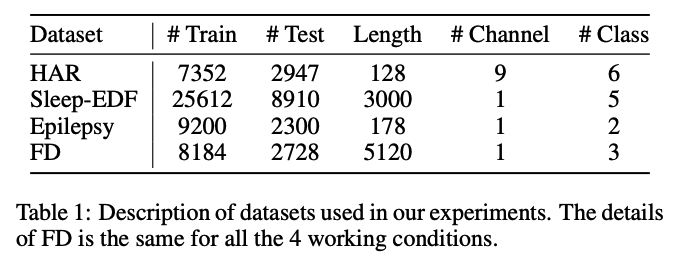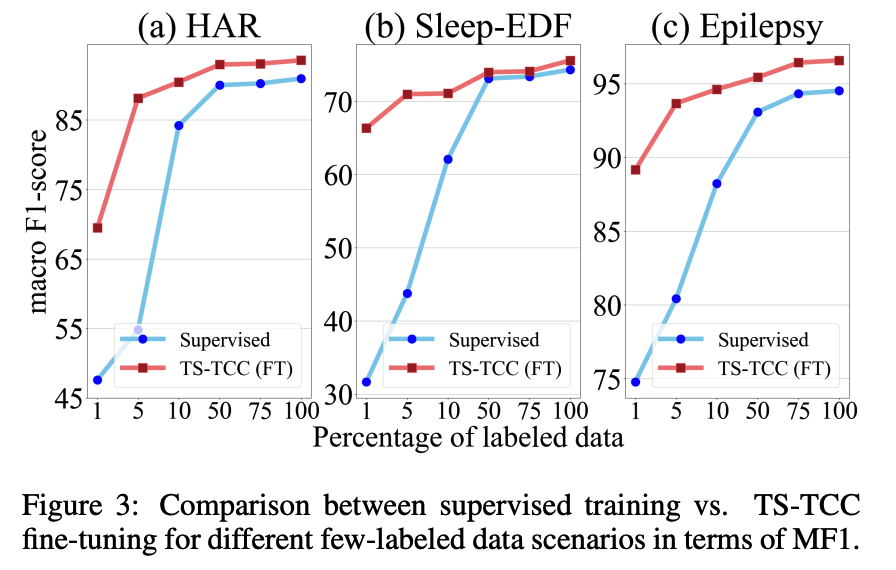Time-Series Representation Learning via Temporal and Contextual Contrasting
Contents
- Abstract
- Introduction
- Methods
- TS Data Augmentation
- Temporal Contrasting
- Contextual Contrasting
- Experiments
- Experiment Setups
- Results
0. Abstract
propose an unsupervised TS-TCC
-
Time-Series representation learning framework via Temporal and Contextual Contrasting
- (1) raw TS are transformed with 2 data augmentations
- weak augmentation
- strong augmentation
- (2) novel temporal contrasting module
- to learn robust temporal representation
- by designing cross-view prediction
- (3) propose contextual contrasting module
- to learn discriminative respresentations
1. Introduction
Contrastive Learning
- mostly done in CV
- but not in TS
Why not in TS?
-
(1) may not be able to address the temporal dependencies of data
-
(2) some augmentation techniques generally cannot fit well with TS
propose TS-TCC
- employs simple & effective data augmentations
- propose novel temporal contrastive module
- propose contextual contrasting module
2. Methods

(1) TS Data Augmentation
Using different augmentations can improve robustness of learned representations
Augmentation
- weak : jitter-and-scale
- jitter = add random variations to the signal
- scale = scale up its magnitude
- strong : permutation-and-jitter
- permutation : split the signal into random # of segments ( max # = M ) & random shuffle
- jitter = random jittering
Notation
- input sample : \(x\)
- strongly augmented view : \(x^s \sim \mathcal{T}_s\)
- weakly augmented view : \(x^w \sim \mathcal{T}_w\)
- encoder : \(\mathbf{z}=f_{\text {enc }}(\mathbf{x})\)
- where \(\mathbf{z}=\left[z_1, z_2, \ldots z_T\right]\)
- strongly augmented view : \(\mathbf{z}^s\)
- weakly augmented view : \(\mathbf{z}^w\)
- where \(\mathbf{z}=\left[z_1, z_2, \ldots z_T\right]\)
(2) Temporal Contrasting
given latent variable \(\mathbf{z}\),
use autoregressive model \(f_{a r}\) to summarize all \(\mathbf{z}_{\leq t}\) into a context vector \(c_t=f_{a r}(\mathbf{z} \leq t), c_t \in \mathbb{R}^h\)
- \(c_t\) is used to predict the timesteps from \(z_{t+1}\) until \(z_{t+k}(1<k \leq K)\)
- use log-bilinear model
- \(f_k\left(x_{t+k}, c_t\right)=\exp \left(\left(\mathcal{W}_k\left(c_t\right)\right)^T z_{t+k}\right)\).
Cross-view prediction task
- use \(c_t^s\) to predict future timesteps of weak augmentation \(z_{t+k}^w\)
- use \(c_t^w\) to predict future timesteps of strong augmentation \(z_{t+k}^s\)
Contrastive Loss
- minimize dot product between the predicted representation & true one of same sample
- maximize dot product with other samples \(\mathcal{N}_{t,k}\)
\(\begin{aligned} &\mathcal{L}_{T C}^s=-\frac{1}{K} \sum_{k=1}^K \log \frac{\exp \left(\left(\mathcal{W}_k\left(c_t^s\right)\right)^T z_{t+k}^w\right)}{\sum_{n \in \mathcal{N}_{t, k}} \exp \left(\left(\mathcal{W}_k\left(c_t^s\right)\right)^T z_n^w\right)} \\ &\mathcal{L}_{T C}^w=-\frac{1}{K} \sum_{k=1}^K \log \frac{\exp \left(\left(\mathcal{W}_k\left(c_t^w\right)\right)^T z_{t+k}^s\right)}{\sum_{n \in \mathcal{N}_{t, k}} \exp \left(\left(\mathcal{W}_k\left(c_t^w\right)\right)^T z_n^s\right)} \end{aligned}\).
Use transformer as the AR model
(3) Contextual Contrasting
-
to learn more discriminative representations
- \(2N\) contexts
- positive pair : \(\left(c_t^i, c_t^{i^{+}}\right)\)
- negative pair : remaining \((2 N-2)\) pairs
- loss function :
- \(\mathcal{L}_{C C}=-\sum_{i=1}^N \log \frac{\exp \left(\operatorname{sim}\left(c_t^i, c_t^{i^{+}}\right) / \tau\right)}{\sum_{m=1}^{2 N} \mathbb{1}_{[m \neq i]} \exp \left(\operatorname{sim}\left(c_t^i, c_t^m\right) / \tau\right)}\),
- where \(\operatorname{sim}(\boldsymbol{u}, \boldsymbol{v})=\boldsymbol{u}^T \boldsymbol{v} / \mid \mid \boldsymbol{u} \mid \mid \mid \mid \boldsymbol{v} \mid \mid\)
- \(\mathcal{L}_{C C}=-\sum_{i=1}^N \log \frac{\exp \left(\operatorname{sim}\left(c_t^i, c_t^{i^{+}}\right) / \tau\right)}{\sum_{m=1}^{2 N} \mathbb{1}_{[m \neq i]} \exp \left(\operatorname{sim}\left(c_t^i, c_t^m\right) / \tau\right)}\),
- Overall self-supervised loss :
- \(\mathcal{L}=\lambda_1 \cdot\left(\mathcal{L}_{T C}^s+\mathcal{L}_{T C}^w\right)+\lambda_2 \cdot \mathcal{L}_{C C}\).
3. Experiments
- Experiment Setups
- Datasets
- Implementation Details
- Results
- Comparison with Baselines
- Semi-supervised Training
- Transfer Learning
- Ablation Study
(1) Experiment Setups
a) Datasets
3 public datasets + 1 additional dataset ( for transfer learning )

-
HAR (Human Activity Recognition)
- 30 subjects
- num classes = 6 activities
-
Sleep-EDF (Sleep Stage Classification)
- num classes = 5 EEG signals ( W, N1, N2, N3, REM )
-
Epilepsy (Epilepsy Seizure Prediction)
-
500 subjects
-
num classes = 5 \(\rightarrow\) 2
( 4 of them do not include epileptic seizure \(\rightarrow\) group them into 1 class )
-
-
FD (Fault Diagnosis)
- for transferability experiment
- num domains = 4 different working conditions ( A, B, C, D )
- num classes = 3 class ( per each domain )
- inner fault / outer fault / healthy
b) Implementation Details
-
train/val/tes : 60/20/20
-
etc) SleepEDF : subject-wise split
-
repeat experiment for 5 times ( 5 different seed )
- report mean & std
-
epochs : 40
( both for pretraining & downstream tasks )
-
batch size : 128 ( 32 for few-labeled data experiments )
-
Adam optimizer
(2) Results
a) Comparison with Baselines
Baselines
- (1) Random Initialization:
- training a linear classifier on top of frozen and randomly initialized encoder
- (2) Supervised:
- supervised training of both encoder and classifier
- (3) SSL-ECG
- (4) CPC
- (5) SimCLR
- use our timeseries specific augmentations to pretrain SimCLR
[ standard linear benchmarking evaluation scheme ]
To evaluate the performance of SSL-ECG, CPC, SimCLR and TS-TCC ….
- step 1) pretrain ( w.o labeled data )
- step 2) evaluation ( with a portion of the labeled data )
- standard linear evaluation scheme
- train a linear classifier on top of a frozen SSL pretrained encoder model

b) Semi-supervised Training
semi-supervised settings
- by training ( = fine-tuning ) the model with 1%, 5%, 10%, 50%, and 75%

c) Transfer Learning
- use Fault Diagnosis (FD) dataset
- adopt 2 training schemes on the source domain
- (1) supervised training
- (2) TS-TCC fine-tuning
- fine tune the pre-trained encoder,
- using the labeled data in source domain

d) Ablation Study
Notation
- TC = Temporal Contrasting module
Model variants
- (1) TC only = train TC without the cross-view prediction task
- each branch predicts the future timesteps of the same augmented view
-
(2) TC + XAug = train the TC with adding the cross-view prediction task
- (3) TS-TCC (TC + X-Aug + CC) = whole version
- (4) Single Augmentation
- (4-1) TS-TCC (Weak only)
- (4-2) TS-TCC (String only)

